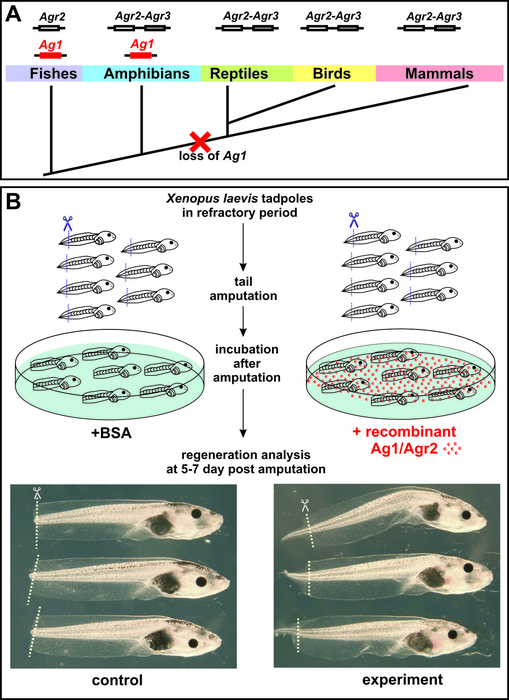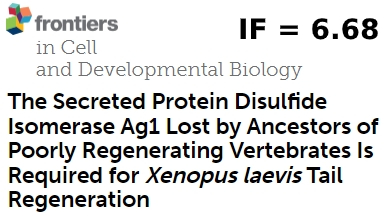Press-room / news / Science news /
The secreted protein disulfide isomerase Ag1, lost by ancestors of poorly regenerating vertebrates, is required for Xenopus laevis tail regeneration
As is known, unlike cold-blooded vertebrates, warm-blooded vertebrates are not able to regenerate such complex structures as a limb or tail. Earlier, researchers from the Laboratory of Molecular Bases of Embryogenesis IBCH RAS proposed a hypothesis about the relationship between the weakening of regenerative abilities in warm-blooded animals and the loss of some genes that regulate regeneration in cold-blooded animals. In support of this hypothesis, we showed that there are indeed genes essential for the regeneration among the found genes lost by warm-blooded vertebrates, particularly the gene for the secreted disulfide isomerase Ag1. Strong activation of this gene on 1 and 2 days post-amputation of the tail in a model object, the frog Xenopus laevis tadpoles, indicated its essential role at the beginning of regeneration processes. It was shown that knockdown of ag1 reduces the ability to regenerate the amputated tail. At the same time, this ability can be restored either by overexpression of ag1 or by the addition of its recombinant protein to the tadpoles.
The phylogenetic analysis of proteins of Agr family of secreted disulfide isomerases showed that it consists of three sub-families, Ag1, Agr2, and Agr3. The genes of agr2 and agr3 sub-families present in all classes of vertebrates, in contrast to the genes of ag1 sub-families, which present only in well-regenerating cold-blooded animals (Fig. 1 A). In this work, we applied several methods for suppressing ag1/agr2 expression in the tails of Xenopus laevis tadpoles and demonstrated that the regeneration of all tail tissues is blocked if these genes are downregulated. Suppression of their expression in cells of the amputated tails was accompanied by inhibition of genes regulating signaling pathways essential for regeneration (Fgf20, Msx1, Wnt5), suppression of cell proliferation and of cell cycle regulators expression (cyclinD1, CDK4, cdca9). This set of data confirms the essential role of ag1/agr2 in the regulation of regeneration and suggests that the loss of one of these important regulators, namely ag1, lost by the ancestors of warm-blooded animals could have influenced on the efficiency of regeneration in the latter.
The Xenopus laevis tadpoles have a developmental period called the refractory period, when the tadpole's ability to regenerate is strongly suppressed and is accompanied by blocking the expression of the Ag1 and Agr2 genes in response to tail amputation. In this regard, it would be of great interest to test if the artificially increased concentration of Ag1 and Agr2 proteins in tadpoles will be sufficient to restore their ability to regenerate tail regeneration in the refractory period. Indeed, we demonstrated that tadpoles with artificially enhanced expression of ag1 or agr2 were much more efficient in the regeneration of their tails amputated during the refractory period compared to their wild-type siblings. Moreover, incubation of tadpoles in a medium containing the recombinant proteins Ag1 or Agr2 also led to an increase in the percentage of normally regenerating tails by 5-6 times (see Fig.1 B). The data obtained are of great interest for regenerative medicine and require further research using model systems for mammalian regeneration.
This work was supported by the Russian Foundation for Basic Research (No. 20-34-70058, No. 18-29-07014 and No. 20-04-00675) and published in Frontiers in Cell and Developmental Biology journal.

Figure 1
october 6, 2021


